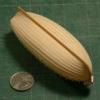-
Posts
13,324 -
Joined
-
Last visited
Content Type
Profiles
Forums
Gallery
Events
Everything posted by druxey
-
Oh, my. That is one quantity of knees to be fitted! I wish you well on this particular journey, Ed.
- 3,618 replies
-
- young america
- clipper
-
(and 1 more)
Tagged with:
-

Deck beam Scarphs?
druxey replied to NMBROOK's topic in Building, Framing, Planking and plating a ships hull and deck
wq: I did mean left and right, as viewed from above! -

Deck beam Scarphs?
druxey replied to NMBROOK's topic in Building, Framing, Planking and plating a ships hull and deck
wq: Deck beam scarphs seem always to have been made in the vertical plane. Counterintuitive, I know! Certainly wide span beams had supporting pillars under them. -
Castello Boxwood or Lemonwood are very similar if not identical species.
-
I agree that the inside looks good from that angle, Ben. However, it's harder to hide any unfairness outside the hull!
- 889 replies
-
Thanks for posting this interesting image. This is something I've never seen in other paintings and is perhaps an important historical detail. Are you free to tell us the location of this painting, Barking?
-
Thanks for taking my comments in the spirit that they were intended, Ben! That astern photo seems to indicate that they are sitting high.
- 889 replies
-

water way?
druxey replied to jhl's topic in Planking Techniques's Click Here for Topics dedicated to planking!!!!
By now you realize that the answer is 'it all depends'. The more specific you are as to the time and place that the ship was built, the more precise an answer you will get from the experts on this site. -

Deck beam Scarphs?
druxey replied to NMBROOK's topic in Building, Framing, Planking and plating a ships hull and deck
I imagine at this time period 30' 0" lengths of timber were easily available, which is more than 8 meters. I suppose, depending on the geographic location of the shipyard, if only shorter lengths were available they would have scarphed them together. You are the master shipwright: you decide! -
Nice job on the gratings, Toni. Also nice-looking capstan partners.
- 1,449 replies
-
Looks good, Ben. You might want to check the second and third cants from aft: they look to be sitting a bit high and will give you a problem later when it comes to fairing. All they will need is a little shaved off their feet to lower them after you've broken out the isopropanol.
- 889 replies
-

20 gauge shackles
druxey replied to michael mott's topic in Metal Work, Soldering and Metal Fittings
I've used the 'melted end' technique and find controlling the process quite tricky. It's hard to do this consistently. Looks like you've nailed the technique though. -
I sent this comment to Conway: Please pass on my sincere thanks to John for having made such a significant contribution to the ship modelling publishing world. In the early days of Model Shipwright, this was my only window into what others were doing in the field. Working in isolation, Model Shipwright was a valuable tool for me as well as many others, I am sure. Every best wish to John in his well-earned retirement.
-
It is amazing what we can learn from other model-makers, as well as what one invents for oneself, when one has to! I appreciate all the model makers on this site who are willing to share their knowledge.
- 1,215 replies
-
- sloop
- kingfisher
-
(and 1 more)
Tagged with:
About us
Modelshipworld - Advancing Ship Modeling through Research
SSL Secured
Your security is important for us so this Website is SSL-Secured
NRG Mailing Address
Nautical Research Guild
237 South Lincoln Street
Westmont IL, 60559-1917
Model Ship World ® and the MSW logo are Registered Trademarks, and belong to the Nautical Research Guild (United States Patent and Trademark Office: No. 6,929,264 & No. 6,929,274, registered Dec. 20, 2022)
Helpful Links
About the NRG
If you enjoy building ship models that are historically accurate as well as beautiful, then The Nautical Research Guild (NRG) is just right for you.
The Guild is a non-profit educational organization whose mission is to “Advance Ship Modeling Through Research”. We provide support to our members in their efforts to raise the quality of their model ships.
The Nautical Research Guild has published our world-renowned quarterly magazine, The Nautical Research Journal, since 1955. The pages of the Journal are full of articles by accomplished ship modelers who show you how they create those exquisite details on their models, and by maritime historians who show you the correct details to build. The Journal is available in both print and digital editions. Go to the NRG web site (www.thenrg.org) to download a complimentary digital copy of the Journal. The NRG also publishes plan sets, books and compilations of back issues of the Journal and the former Ships in Scale and Model Ship Builder magazines.


